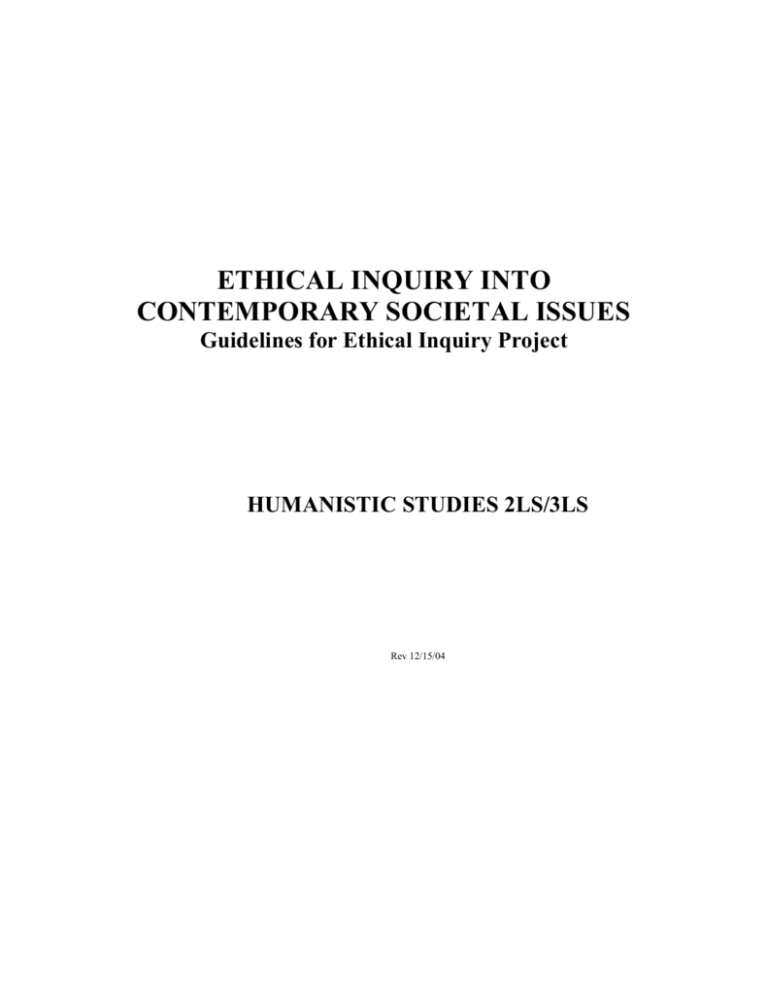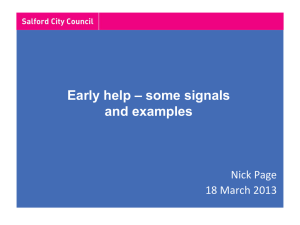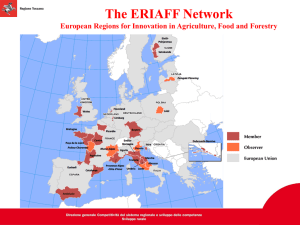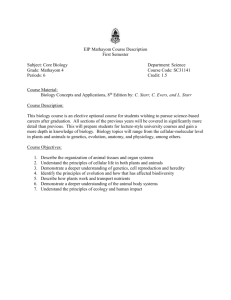Syllabus for Humanistic Studies 2LS/3LS
advertisement

ETHICAL INQUIRY INTO CONTEMPORARY SOCIETAL ISSUES Guidelines for Ethical Inquiry Project HUMANISTIC STUDIES 2LS/3LS Rev 12/15/04 Humanistic Studies 2LS Course Information TABLE OF CONTENTS 1 ABOUT THE COURSE Course Description Goals Tips for Success Attendance The Reading and Writing Center 2 2 3 3 3 3 GUIDELINES FOR THE EIP EIP Controversy Controversy Selection Specific Criteria for your EIP Controversy How to Choose a Controversy Expanding your Ideas 4 4 4 5 5 6 WRITING THE PAPERS Writing Paper 1- The Introduction Writing Paper 2- Presentation of Arguments Writing Paper 3- Conclusions and Solutions Works Cited- Bibliographic and Internet References Using the Internet 7 7 9 10 11 12 APPENDIX Planning Your EIP Papers 13 1 Humanistic Studies 2LS/3LS ABOUT THIS COURSE: Course Description Humanistic Studies 2LS/3LS: An Ethical Inquiry into Contemporary Societal Issues is unlike most of the classes you've taken at Los Medanos College. As opposed to courses that teach you a lot of CONTENT, this class is designed to teach you the Ethical Inquiry METHOD. This method is something you can apply for the rest of your life as you are faced with ethical dilemmas that deal with questions of "right" and "wrong": Should you let your friend know his/her spouse is cheating? Is it time to put Grandma into a nursing home? Should big box stores like WalMart be allowed in Contra Costa County? Should public schools teach evolution? Is it fair to charge community college students who already have bachelor's degrees $50 a unit? Because this course focuses on teaching a method, you'll find that different 2LS/3LS teachers will cover different topics, although they'll ALL be using these topics to teach the Ethical Inquiry Method. Most of the topics we're teaching are complex and interdisciplinary. This means that you'll use the knowledge and skills you've learned in all your college classes in Humanistic Studies 2LS/3LS. We highly recommend that you take this course after a full year of General Education classes. Having a little history, psychology, sociology, science, philosophy, math, and especially critical thinking will help you enormously in this class. Because of this advanced level, many students find Humanistic Studies 2LS/3LS one of the most rewarding and challenging classes at Los Medanos College. You will be forced to grapple with complicated issues and confront the limits of your own knowledge and perceptions. The "backbone" of the course is the Ethical Inquiry Project project (EIP) which is a 20-page research paper your professor will guide you through as the semester continues. Because of this intensive writing project, we also strongly recommend that you take this course after you've completed English 10LS, and even better, after English 21LS. 2 The Goals of This Course • • • • • To provide an interdisciplinary study of selected societal issues. To develop skills, knowledge, and attitudes necessary to promote self-directed and continued learning. To investigate the assumptions and foundations beneath one's own and society's values. To search out the value components and ethical consequences in societal issues and their possible solutions. To develop students' critical thinking and research skills Tips For Success This course requires a great deal of background information. To get this information: 1) Take this as your last course 2) Read a daily newspaper 3) Watch a daily news report 4) Use the Reading and Writing center Attendance Because this class focuses on a METHOD it is crucial that you attend class. Bottom line, if you miss class it will be difficult to learn the method by only reading the text. Regular attendance and being on time are essential for success in this course. Classroom discussion, lecture, explanation, and exercises constitute a very important part of the class. The Reading And Writing Center Consultants for EIP papers are provided by the Reading and Writing Center. This is a quality service in high demand, so make sure you make appointments in advance. Their comments may require substantial rewrites. Make sure to allow time to revise your papers. The Reading and Writing Center, located in LRC 1, provides individual consultation to students and staff on reading and writing assignments across the curriculum. Students are encouraged to work with a faculty consultant to learn skills and strategies for using reading and writing as a means of effective communication in all their courses. Scheduled appointments are encouraged but drop-ins are welcome. Sit in a cozy chair and read while you wait! (925) 439-2181 ext 3176. Remember to bring your syllabus or assignment sheet to your appointment so the consultant will know what you are working on. 3 GUIDELINES FOR THE ETHICAL INQUIRY PROJECT PROJECT: The Ethical Inquiry Project project (EIP) is a 20-page research paper, written in installments, that serves as the foundation of Humanistic Studies 2LS/3LS. Your professor will help you choose your own ethical question to investigate and then guide you through the papers. Once you've completed the last paper, you will have applied the Ethical Inquiry method in its entirety to a real controversial issue. Here's a summary of how each paper will be focused: EIP I is a clear description of the controversy, and a personal reflection on your own values and biases in relation to this issue. EIP II is an objective presentation of the arguments, and a summative commentary on those arguments. EIP III is an ethical analysis of all sides' positions which culminates in a presentation of and argument justifying your own solution. The EIP project is worth the majority of your grade in this course and is a truly unique assignment. While the training in your other GE courses, especially your Critical Thinking courses, will help you with this project, you'll find that the EIP assignment is very different from many of your past assignments. The rest of this guide gives you detailed instructions and assistance; please read it thoroughly and ask your professor lots of questions! EIP Controversy Critical and ethical thinking skills are modeled during class instruction. Controversial issues dealt with in class focus on two topics - the natural environment and social inequality. Environmental controversies tend to deal with environmental degradation, the loss of vital material resources, and the burden of government regulation. The environment section weighs the balance between the environmental health of the planet and global economic growth. The section on social inequality examines claims that particular groups in society are not being treated fairly: they are denied freedoms and/or resources they require to realize their human potential. Gays demand the right to marry, for example; urban minorities demand increased school funding. The term social inequality implies a national commitment to improving the welfare of all its citizens. But what are the rights and responsibilities of both individuals and government in achieving this end? The answer to this question bears weight in shaping public policy. Controversy Selection The topic for your Self-Directed Study (EIP) paper must be controversial. It should involve ethical issues of right and wrong. Pick a controversy you are interested in, but 4 not so passionate about that you would find it difficult to be objective. While personal interest is a strong factor in making this choice, you should choose topics that you are able to objectively review from all sides. Choosing an appropriate topic is a critical part of the project. It must be framed as an ethical question usually beginning with a "should". Please remember to obtain the instructor's approval of your topic at an early stage before you start writing. Since all three papers will focus on a single topic, it's important to define your topic properly. All three papers follow the method of ethical inquiry; each paper should emphasize a different approach to the problem as defined below. Specific Criteria for your EIP Controversy: The controversy, which you select for your EIP project, must: 1. Have at least two opposing sides; in other words, be controversial. 2. Deal with the ethical issues. 3. Be sure it's not a factual question. "How much do we spend every year on aid to dependent children?" is not an ethical question. It's one of the facts you need to research in order to explore a deeper ethical question. 4. Avoid "loaded language." Be sure it's not a rhetorical question, or one which already implies the answer, such as, "When are we going to stop wasting taxpayer's money on welfare cheats?" 5. You controversy is a question, phrased neutrally, that poses an ethical dilemma, that is, something that involves right versus wrong. Examples: Examples of appropriate controversies for your EIP project are: Should U.S. corporations transport toxic wastes to poor nations, or to poor areas, such as Native American reservations, for disposal? Should health insurance and other benefits be available to unmarried "domestic partners"? Should the U.S. continue to apply sanctions against nations with documented human rights violations? Should the laws against clitorectomy be expanded? Should breed specific dog legislation be allowed? How to choose a Controversy Newspapers, television, radio and talk shows are good sources for controversies. As you look over these ask yourself if these issues could affect your life or that of your family. Try to pick a controversy you truly wish to understand. Try to present the controversy as it is currently being discussed in the public realm. If you are having trouble choosing a controversy ask yourself the following questions: 5 1. Am I currently involved in a volunteer organization that advocates a certain viewpoints, (ex. MADD, DARE, PAL)? Many of these orgs are dealing with controversial issues now. 2. Am I or someone I know affected by social issues such as: alcohol or drug use/abuse, child abuse; toxic waste; hate crimes; sexual harassment? 3. Am I simply curious about a current controversial issue? Expanding your Ideas: Once you choose a controversy you should be aware of the amount of source material. In some cases numerous arguments can be found for one side only. You will need to investigate the availability of information before you start writing. Internet sources are excellent for getting the most current information on a controversy; however, books are more useful in understanding the history, development and/or evolution of this problem. Furthermore, book, articles and journals are the most useful in providing concepts, theoretical models and classifications that can save time and work in organizing arguments. In addition, you will be asked to reflect on your own experiences, background, and the values that inform your perspective. 6 WRITING THE PAPERS: Some overall comments: The EIP Project is meant to help you acquire research, critical thinking, and ethical reasoning skills, and to apply them to controversial subjects. As an ethical inquiry course, Humanistic Studies 2LS/3LS requires students to not only study social problems, but also think deeply and with conviction about possible solutions. Though, ultimately your personal opinion matters, it carries little persuasive power unless it is supported by informed arguments, and subjected to critical analysis. EIP papers, each with their own particular objectives, are designed to guide you successfully from a mere untutored opinion to a fact-based, ethically grounded solution. The first step in EIP 1 is to define the problem clearly and to recognize biases. The 2nd paper, EIP II, requires you to present arguments fairly for each side of the controversy. The 3rd paper, EIP III, requires you to formulate a solution or policy as well as its theoretical justification. It is hoped that at the end of this process you will have acquired the knowledge and skills that will assist you in future positions of leadership that await your future. Format: All of your EIP papers should have a title page, be double spaced, use a font no smaller than 12, have a works cited page (bibliography), and be 6-8 pages in length. For EIP 1 you will need 5 sources, 3 of which must be published. For EIP 2 you will need 10 sources, the 5 you cited in EIP 1 plus 5 more. For EIP 3 You will not need any additional sources. At least five sources for EIP 1 and EIP 2, and more likely up to ten sources, are necessary to present the balanced and fair-minded evaluation necessary to earn a good grade. Sources must come from different media; e.g., magazines and newspapers, books, interviews and Internet research. WRITING PAPER 1-THE INTRODUCTION: EIP 1 is divided into two parts. It is very important to keep these two parts separate. The first part is an objective presentation of the controversy. By controversy we mean how it appears as a public concern, not necessarily as it appears in your own mind. The second part of EIP 1 is a subjective reflection on your thoughts and feelings regarding this issue; in short an investigation of your biases and how their life experiences that shaped them (family, heroes, church, or traumatic experiences). This paper provides an introduction to the issue you have chosen. It states clearly why this is a controversial issue. It analyzes the values, rules, beliefs or guidelines used to take a position on this issue. It articulates as least two positions that can be taken on the issue. In this paper you will need to: 7 • • • • • • Define the controversy Explain why you chose this issue Articulate your history and viewpoint with the issue Explain your own biases Name the key players involved and briefly give their viewpoints Conclude with a summary and state your future direction for EIP 2 Part I Objective (1 - 3 pages) 1. Describe the controversy clearly; provide enough information so that the reader will know what this issue is essentially about. a. It should include: 1) A definition of key concepts (ex. If the issue is clitorectemy, what is clitorectomy). 2) A brief history of the controversy. 3) Identify the key players and their viewpoints. a. Save details of the arguments for and against for EIP 2. b. Key players refer to individuals and organizations that speak out on this issue. (Ex., ACLU that defends the rights of minorities to have computerized voting; Rush Limbaugh who argues on talk radio for cutting taxes. Part II Subjective (3-5 pages) In this section you will write in the first person (EX., I think, I feel, etc.) and explain the following. 1. What is your relationship to this controversy? What and how did you come to know about it? a. Did you hear about it through radio, TV, or newspapers. b. Have you been involved in organizations such as the Sierra Club, or the NRA, that are linked to this controversy? c. Are you the member of a group: welfare mother, SUV driver, pittbull owner; that is affected by this problem? 2. Reflections on your beliefs and values. a. What beliefs and values support your views of this problem? How did you acquire these beliefs and values? You may discover that your feelings about the controversy in question are in conflict. Values that we hold dear are not always in accord. Explain how your values come into conflict with regard to this issue. b. In order to answer this question you should examine: 1. The beliefs and values that your parents held and tried to pass on to you 2. The influences of your religion, the media, your subculture, and your significant relationships. 8 3. Did you uncritically accept these beliefs and values? Were you rebellious? Did you question authority? In order to overcome your personal biases you must first be able to recognize them. However, to assert the rightness of your views is not the same as recognizing bias. To recognize bias is to take a third person view of you. WRITING PAPER 2-PRESENTATION OF ARGUMENTS: You will extract from all the information you have gathered, the best arguments that each side gives to support its position, and the best reasons, including numerical data, historical facts, anecdotal evidence, scientific findings, and logical reasoning, for supporting said arguments. It is not your job to provide justifications for these arguments. Your job is to represent as accurately as possible the justifications the opposing parties offer for their arguments. (For example, Muslim clerics who oppose the establishment of Christian missions in the Middle East often compare this incursion to the Crusades in the Middle Ages. If so, explain how these Muslim clerics' version of history supports their argument. Include only those historical details that serve the argument. In other words, do not write a history of the Crusades. You should instead present that version of history that is shared by Muslim clerics themselves, those historical events they point to to support their arguments. This paper should be written in the third person (him/her, they), in a standard research style. Suggested format for Paper 2 There are two possible ways of organizing these arguments: Option I 1. Claims of Supporting Side a. Argument I - Support/Evidence b. Argument II – Support/Evidence c. Etc. (continued argument) 2. Claims of Opposing Side a. Argument I - Support/Evidence b. Argument II – Support/Evidence c. Etc. (continued argument) Option II Point/Counterpoint 1. The main advantage to option one is that it is easier to keep the paper on track. However, because many arguments are technically counterarguments, the second option of point/counterpoint may flow more naturally because it allows you to stay on topic. 9 You will find in the articles you research that when arguments are presented they often are immediately followed by rebuttals from the other side. While option II is more common because it is more appealing, you may find it difficult to keep stay on track. In this case, it may be better to have a strict separation of the two sides as in option 1. 2. Commentary - this paper should conclude with your assessment, or critical commentary (your take or reaction) to these arguments and evidence that you have just presented. How would you characterize the arguments given by both sides? Do they tend to emphasize individual responsibilities as opposed to social obligations? Do they contain moralistic overtones? Are they politically inspired? Are they motivated by profit, economic gain? Your own judgment is relevant to the solutions you will be considering in your EIP III. WRITING PAPER 3-CONCLUSIONS AND SOLUTIONS: Suggested format for Paper 3 In paper 3 you will offer an ethical analysis and a solution to the problem you have been researching. At the close of the paper, you will briefly reflect on the process you have been engaged in from EIP I through EIP III. 1. Frame the problem. What do you believe is the most important thing to know in order to solve this problem? Here you are taking a stand and setting up your solution with a brief discussion of the values and priorities which you believe any solution would have to take into account. For example, in addressing the wage disparity that exists between men and women, one might consider that the most important thing to know in order to solve this problem is that the number of households headed by women continues to increase. Another example: one might consider that terrorism and national security are the most important considerations in deciding whether racial profiling is justified. Your assignment of priority and the reasoning behind it is the logical foundation of your solution. In this section you should defend what you think is important or essential about the facts that you have garnered in your research. In other words, justify your own claims regarding what is important 2. The Solution: In presenting your solution you will encounter the following options: a. b. c. 3. You agree with a solution by one of the parties to the argument. You mix parts of various proposed solutions to create your own solution. You come up with a whole new way of solving the problem. What are the strengths and weaknesses of this solution? 1. Is it practical? Is it effective? 2. What does the solution cost? Consider economic, social, political and human costs associated with your solution. 3. Does your solution create as well as resolve problems? Remember no solution is 10 perfect. A solution thoroughly presented is forthcoming about possible downsides. 4. Anticipate criticism. 4. Ethics: Is it fair because it upholds a cherished ideal? Because it fulfills an important social obligations? Because the consequences are favorable? How is the greater good served by your solution? 5. Conclusion: Self-reflections How has your thinking about this problem changed? Has your position changed? Refer back to EIP I and compare it to your present view. What influenced you the most as you researched this issue? Works Cited-Bibliographic And Internet References You should exercise care in selecting your sources. You need to present a balanced range of sources (not just those from only one side of your question). You should try for sources that present their information in a fair-minded way. If your sources have obvious biases, you need to keep that in mind when evaluating the accuracy of the information you obtain. Sources should be up-to-date and current -- you must use the most recent sources available. For EIP 1 you will need 5 sources. For EIP 2 you will need 10 sources (5 from EIP 1 and 5 additional sources). For EIP 3 You are not required to have any additional sources. At least five sources for both EIP 1 and EIP 2, and more likely up to ten sources for each paper, are necessary to present the balanced and fair-minded evaluation necessary to earn a good grade. Sources must come from different media; e.g., magazines and newspapers, books, interviews and Internet research. There are many sources of information available to you. You can find materials in the Learning Resource Center, and the Contra Costa County Library, for example. You should rely most of all on information in current newspapers and periodicals and on articles in scholarly journals. You may also find appropriate information on videos/TV, or in interviews with experts or involved citizens. Be careful not to base your entire paper on things from TV. Similarly, you might illustrate your point with anecdotal stories and testimony ("I had a neighbor who worked in welfare. And he said . . . ") However, it is important to exercise caution in using such limited material. You will need to evaluate the potential bias, values, and perspective of the person telling the story, as well as to verify independently the factual accuracy of the story. The difficulty in verifying accuracy limits the usefulness of such stories in a research project. Finally, there may be basic facts and background information which you find in an encyclopedia; 11 (you should not, however, base the majority of your paper on material from encyclopedias. Encyclopedias are the least desirable source). Be sure to keep track of the sources of your information as you are doing research. Adequate documentation of the material you use in your paper is required for a good grade. If you use a quotation or state a statistic, you must give a source. Papers that are inadequately documented are not acceptable. Your paper must include a Works Cited Page. Either the MLA or the APA style is acceptable. Another important resource is the EBSCO database available in the LRC. You could initially search this electronic database to help you locate important sources. Ask the librarian for assistance in using this important resource. Using the Internet The Internet is a great source of ideas and information. It is important to use it in the beginning of your research to get an idea of the range of information about your topic. Try looking for Internet addresses on your topic that have "edu." or "gov." in the address (the universal resource locator). Remember that you are looking for qualified and knowledgeable sources. In general, "chat lines" do not fit these criteria unless they are designed by universities or educational organizations. These "chat lines" are often limited to subscribers who pay to belong to these sources. When documenting Internet sources, follow MLA or APA format: • • • • Site address Title of material Person or organization as author Date of material was accessed All of your sources must be given in a format that enables the reader to document your research. Readers must have enough information to find the source themselves. 12 APPENDIX A PLANNING Planning the study is a big and important part of the study. Time spent in planning pays off in clarity of objectives, workability of the research plan, and in the quality of the product or process. The following questions are intended to direct your attention to key elements of planning. Think each question through and respond on a separate sheet of paper in writing. What are your strengths in learning and research skills? What learning and/or research skills do you want to develop? What is the tentative topic of interest for your EIP and why did you become interested in this topic? How strongly interested are you in this topic? What resources will be necessary to you to do the EIP? Have you done a preliminary survey to see if necessary resources are available? APPENDIX A WORKSHEET NAME: INSTRUCTOR: COURSE SECTION: DAY: TIME: SELF-DIRECTED STUDY: ETHICAL QUESTION: OBJECTIVES: WHAT DO YOU HOPE TO ACCOMPLISH? RESEARCH: LIST THREE SPECIFIC RESOURCES FOR YOUR PROJECT IN CORRECT BIBLIOGRAPHIC FORMAT: 13







